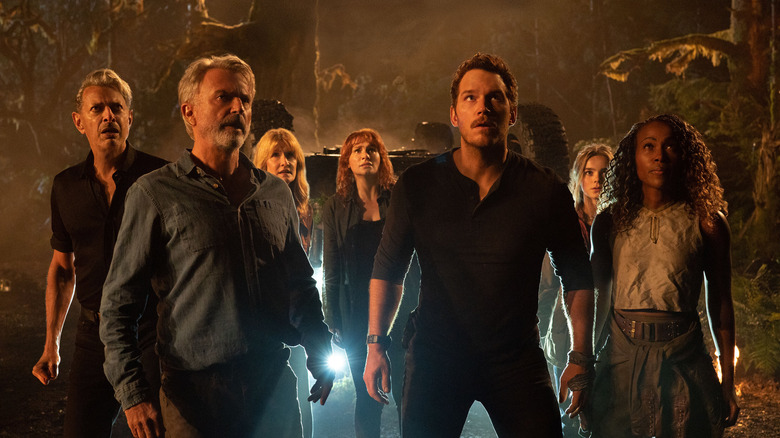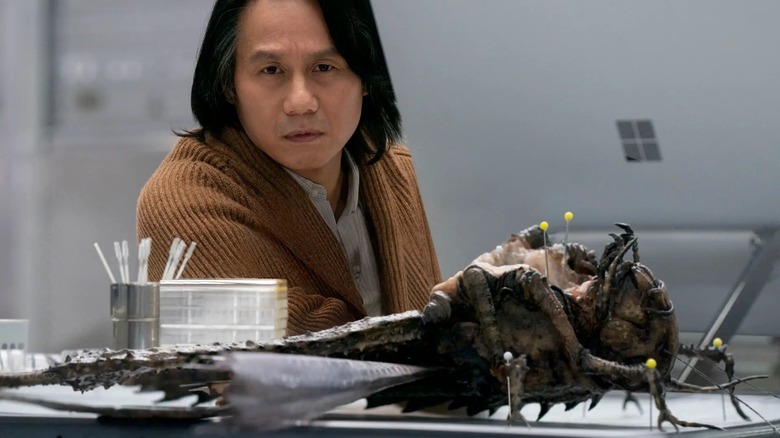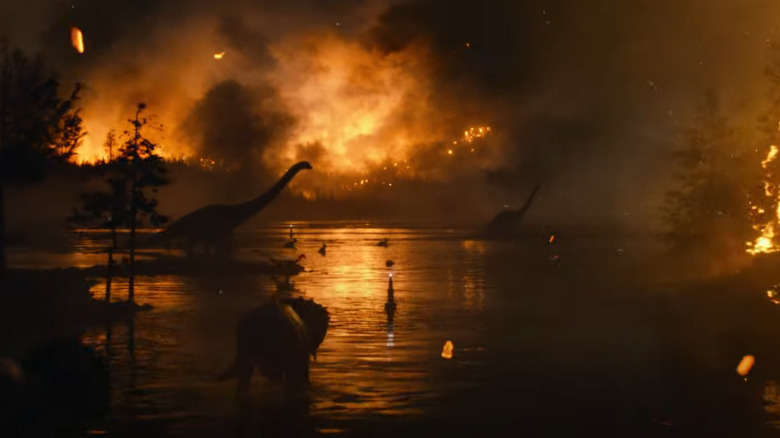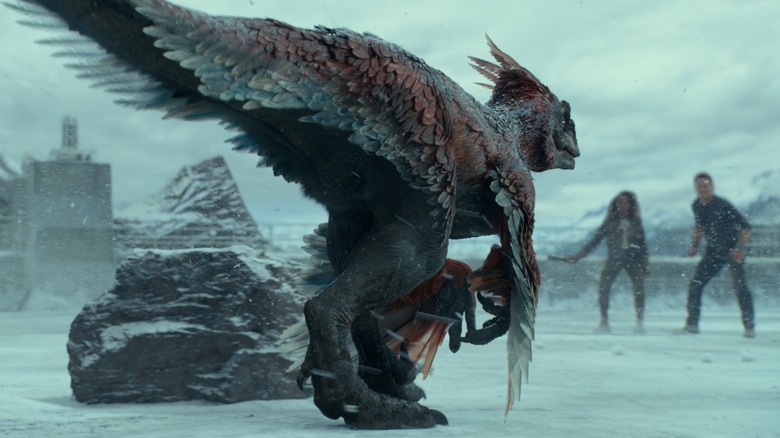Jurassic World Dominion's Crew Actually Burned Down The Locust Containment Set
The "Jurassic World" (née "Park") movies have long been leaders in mixing together various special and visual effects techniques. While the general public may think of the franchise as primarily (or even all) a CGI affair, those in the know (which means you, /Film reader!) are aware that the various dinosaurs and disasters found in the films have both digital and practical elements.
One effects element that could go either way — especially for safety reasons — is fire. In most instances, a movie set burning down is a tragic accident, a mistake that costs a production more time and money to fix after the blaze has been extinguished. Yet that happily isn't the case for "Jurassic World Dominion," where the crew intentionally set fire to one of the sets. The choice helps create an effect that is much more impactful for having a basis in reality, even if the final sequence involves some digital work, too.
Dominion keeps the Jurassic tradition of making its newest creature part practical effect
The most surprising — and controversial — element of "Dominion" is its introduction of a new menace to a world already run rampant with dinosaurs: giant locusts. The genetically modified creatures are the product of the appropriately named Biosyn corporation, their swarms initially intended to insidiously manipulate the world's food supply before it's discovered they present a threat to all life on the planet.
While the locust swarms were created through digital means courtesy of Industrial Light and Magic, visual effects supervisor David Vickery made sure the film's actors had a practical version of the bug to perform with. Speaking to Below the Line, Vickery explained how the production made a physical locust:
"We had a physical prop that Sam Neill could hold when he picked it up out of the cupboard. It had no legs, and it had their wings, but there was a body there that he could hold onto. He would pick this up, and the animatronic piece had moving mouth parts and mandibles."
To further make the illusion of a real giant locust work, ILM added "the wings fluttering and all the legs [moving]," blending a bit of digital animation with the practical effect.
'Why don't I just burn the set down?': Dominion employs the Occam's razor
One of the most visually stunning and disturbing moments of "Dominion" is when Biosyn CEO Lewis Dodgson (Campbell Scott) attempts to cover his tracks by burning the locusts and their lab-based habitat, only to discover that the locusts have found a way out of their cage, and their flaming bodies now endanger the environment and people outside the facility.
David Vickery and director Colin Trevorrow were prepared to create the sequence in a piecemeal fashion, yet special effects supervisor Paul Corbould offered them a far simpler alternative, given that production had otherwise finished shooting on the locust cage set. As Vickery explained:
"Colin and I were talking about how we could shoot elements in order to comp fire elements into the set and make it feel like it was something practical. Paul Corbould put his hand up and said, "Why don't I just burn the set down?' and he built this huge, great big flaming car wash right that went from one end of the set to the other and just torched the entire set."
Trevorrow shot the burning of the locust lab "with eight or nine different cameras in locked-off positions," as Vickery observed, safely capturing the set's destruction by Corbould's clever contraption. Now, instead of Vickery and the ILM crew having to put footage of real fire into a shot of the set, the fire was actually there, creating a far more visceral and practical look for the sequence.
Dominion's effects techniques were inspired by Jurassic World: Fallen Kingdom's director
After the locust set was burned down, the footage was turned over to ILM's Vancouver team, where the artists "very carefully integrated all the burning locusts into that practical fire," as David Vickery explained. The VFX supervisor was proud of the work done on both sides of the effects realm, stating "it was a great collaboration between those two departments to get the best result."
It was exactly what Trevorrow was aiming for with "Dominion," a blend he was inspired to achieve after seeing J.A. Bayona's work on "Fallen Kingdom." In this video for Dolby, the director states how he and the production "went back to basics," calling Bayona "instrumental in discovering some new methods" on how to combine the practical and digital elements for the film's creatures in the most effective way possible. That ethos undoubtedly allowed Trevorrow to have an open mind toward burning a set down on purpose. As demonstrated on the locust set, sometimes the best new effects methods are the oldest and simplest.



